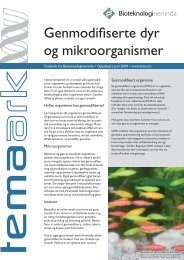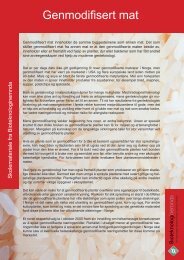Fiskevaksiner og genteknologi â Internseminar - Bioteknologinemnda
Fiskevaksiner og genteknologi â Internseminar - Bioteknologinemnda
Fiskevaksiner og genteknologi â Internseminar - Bioteknologinemnda
- No tags were found...
Create successful ePaper yourself
Turn your PDF publications into a flip-book with our unique Google optimized e-Paper software.
Bioteknol<strong>og</strong>inemnda: <strong>Internseminar</strong> 5. september 2001NN: Which resistance genes do they accept?McDougall: You anticipated. For the most part,they are happiest with the kanamycin/neomycin gene.Drug resistance in E. coli would be to kanamycin, thesame gene works as drug resistance to neomycin ineukaryotes. So it is a drug resistance that works inboth, a gene that works in both. That is what theywould prefer to have it. But basically, every singlecase is looked at separately. If there is a reason whyyou have a different gene in your vector, then theyare willing to listen to the reason. They would prefernot to have one in there, certainly they would prefernot to have an antibiotic gene in there where that is aproblem for example within hospitals– not becausethere is any evidence that shows it spreads, butsimply because of safety perception. Again: there isno evidence that this thing spreads, – yet.3. Fate of DNA after injectionIn fish, a lot of research has been done on whathappens to the protein being produced. Not theplasmid, not the DNA, just the protein being produced.And it is very clear that it is spread throughout thefish. It is spread through the gills, to the liver, and itdisappears after a while (the number of days you lookat depends upon the experiment). With intermuscularvaccines, it’s the same thing: the number of proteinsis high in the muscle, and then goes down, and theproteins disappear after a while. That is the proteinitself. Much less has been done on localisation of theDNA in the fish. Not that people have not tried. Butgenerally no one has been able to find it after a periodof time, and a negative finding does not always meanthat it is not there.In mice and guinea pigs, a lot of work has beendone, where they have put in a huge amount of DNA.10 13 DNA copies were injected, they extracted materialfrom the whole mouse over a period of time and foundthat at six weeks you can find a free plasmid at theplace where they injected, and a very small amount atthe lymph nodes. No integration in the chromosomeshas been found. At six months, much less DNA wasdetected at the injection site and virtually nothing atthe lymph nodes; again nothing was found in anyother tissues. The asset they use is very sensitive, withsensitivity of 1 copy pr. micr<strong>og</strong>ram of DNA, whichis a 1000 times lower than spontaneous mutationfrequency.Just a review of what we have looked at. Thereis no integration at six months or earlier. A lot ofwork has been done on it, and a lot has been doneby FDA/USDA. They are also surprised, but theyalso say they can’t find anything. The DNA plasmid,the DNA vaccine, enters only a few cells for antigenproduction. That’s something to remember. It’s notlike other aspects where you want it to enter a lot ofcells and stay. It enters some few cells at the site ofentry, depending upon where it is introduced, andthese cells produce an antigen for a short period oftime, and the cells are eventually eliminated. You getsome DNA being distributed for a short period aftervaccination, but virtually all plasmid DNA appearsto be degraded extra-cellularly. Very little of the DNAgets into the cells.NN: How do you control which cells itintegrates?McDougall: It doesn’t integrate at all. But as towhat cells the DNA comes in to: If you put it intothe muscle, you will actually be able to see alongthe line of injection those few cells the DNA enters– you can actually see it histol<strong>og</strong>ically when youlook under the microscope. You will see that there issomething different about them, they are producinga huge amount of protein. Again, the reaction is thatthe cell is producing a huge amount of protein whichwill create an immunol<strong>og</strong>ical response against thatprotein. Which is again different from for examplegene therapy, where an immunol<strong>og</strong>ical reactionagainst the gene that you are trying to put in isthe last thing you would want. No integration intochromosomes has ever been demonstrated in anyproper experiment. Again, these are case-by-casestudies by the FDA/USDA or EU; and not enoughhave applied, so they look at every single case whenyou make an application.Other questionsTwo other questions have arised:1. Is DNA vaccination and gene therapy the samething? Yes and no. In both, you have a gene of interest,which you try to put into some cells. On the one handwith vaccination, you want the cell to produce a lotof protein, which causes a reaction immunol<strong>og</strong>icallywhere you will get an antibody response or animmunol<strong>og</strong>ical response against that protein thatwill then be ready to wipe out that protein againwhen they find it on a path<strong>og</strong>enic organism, whenit enters the body. With gene therapy you want theopposite. You want the gene to basically hide itself and12
















